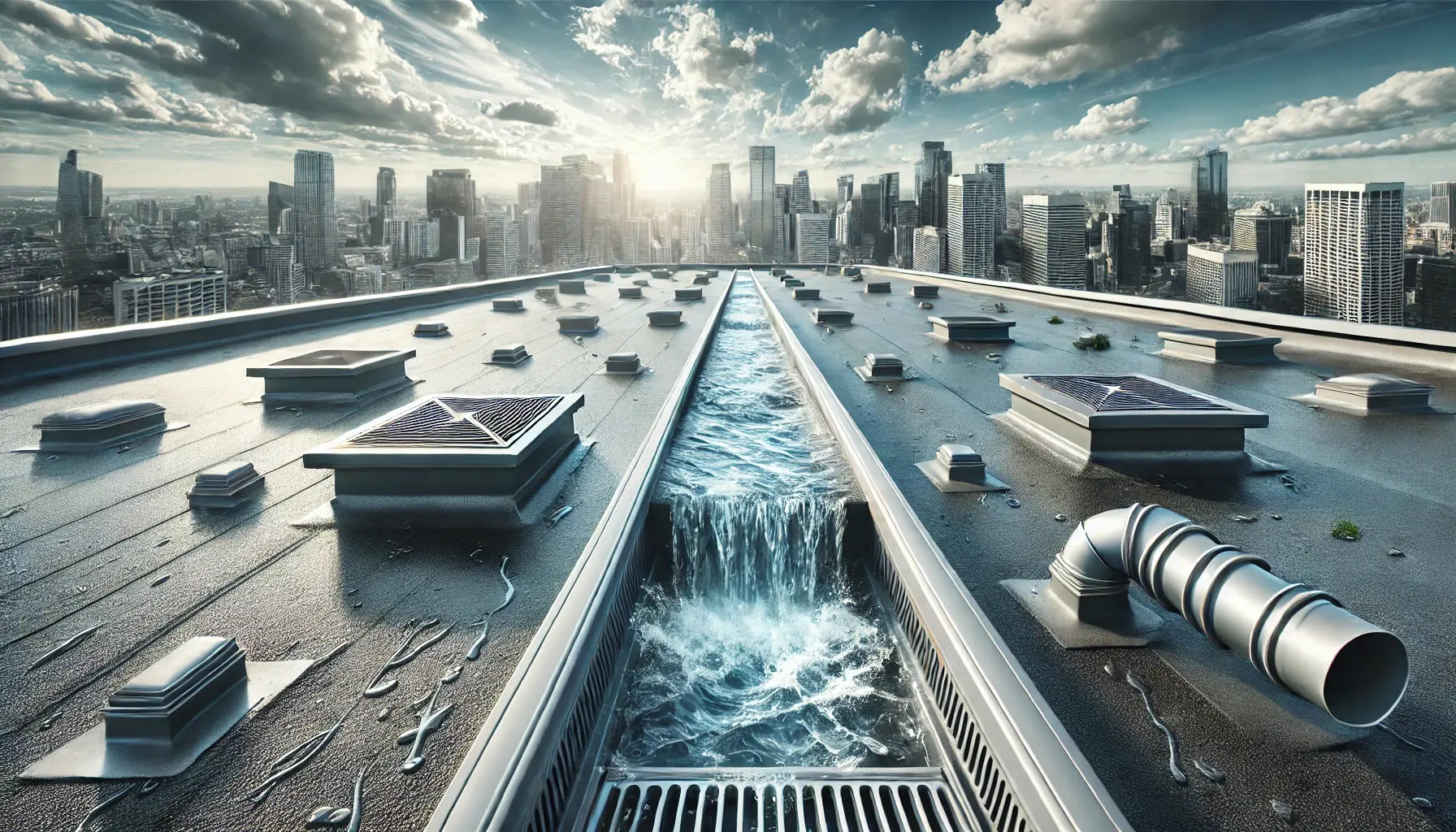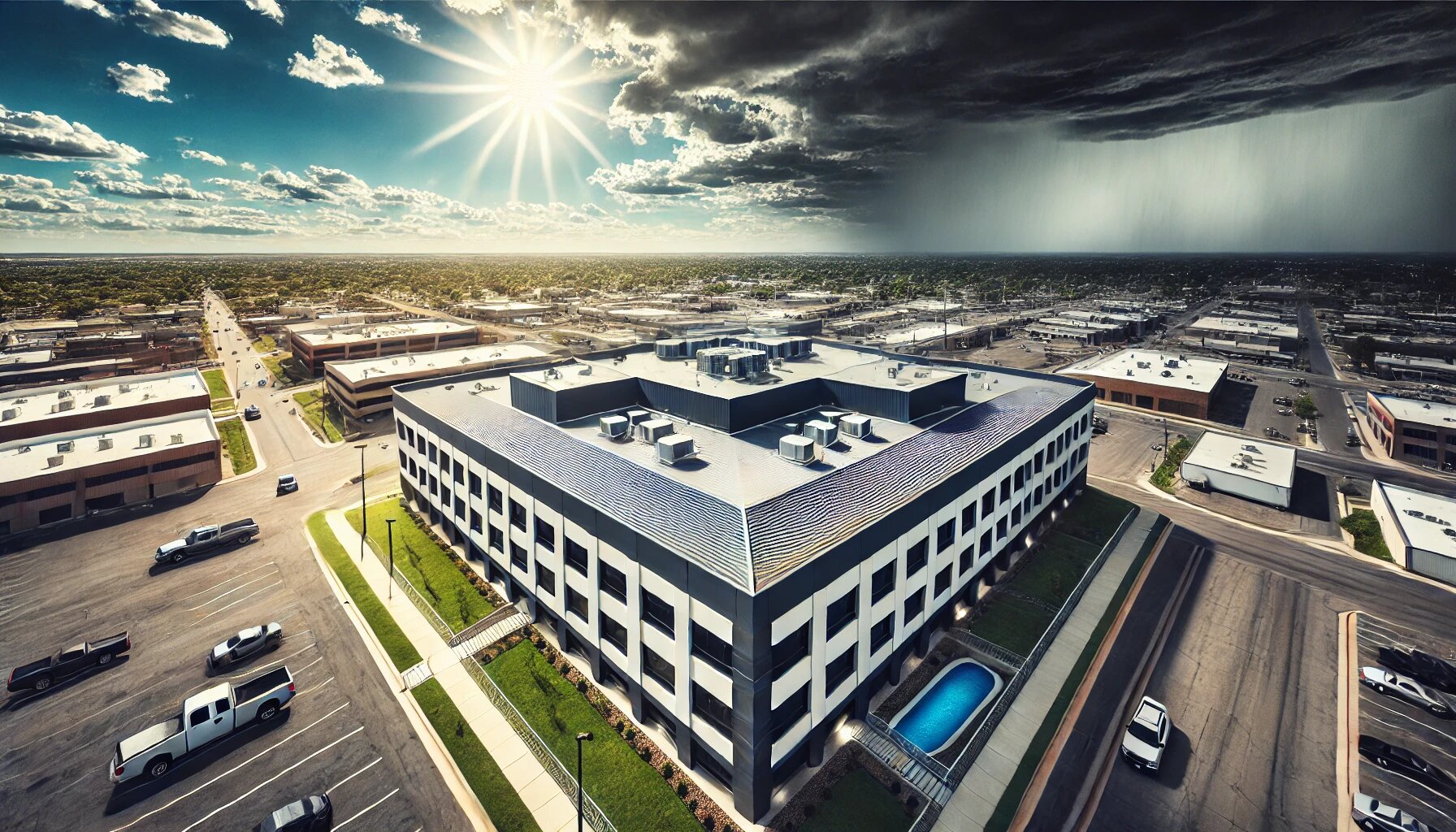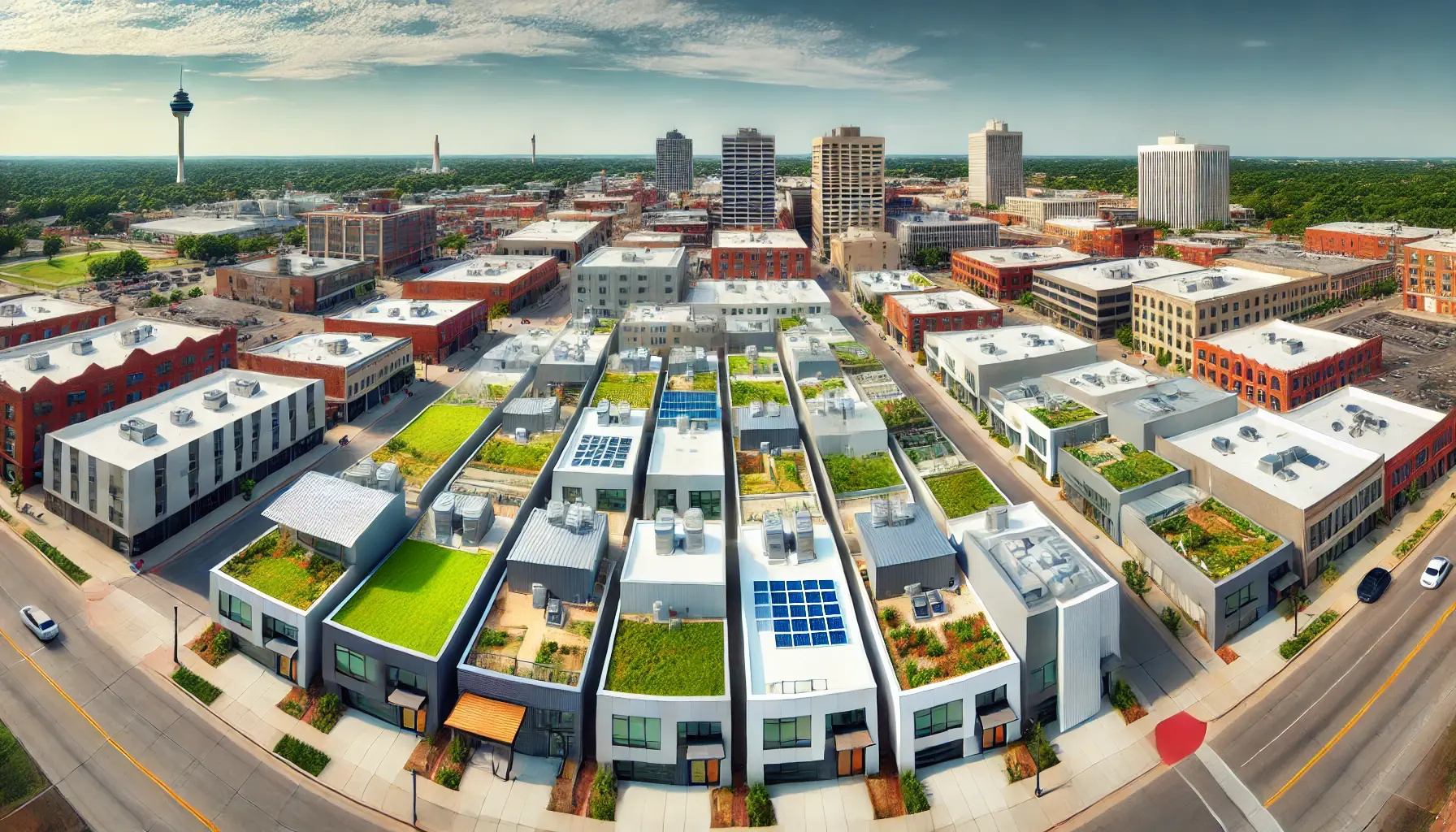Flat roofs are a common choice for commercial buildings in Wichita and nearby areas. They are affordable, easy to maintain, and provide extra space for HVAC systems or solar panels. However, they also come with a challenge—drainage.
Unlike sloped roofs, which naturally direct rainwater away, flat roofs require well-designed drainage systems to prevent water from collecting. If water doesn’t drain properly, it can cause leaks, mold growth, and even structural damage. Some property owners assume that minor ponding is harmless, but over time, standing water speeds up roof deterioration and leads to expensive repairs.
This article explains why proper drainage is necessary, the risks of poor drainage, and the best ways to keep a commercial flat roof in good shape.
Key Takeaways:
- Flat Roofs Require Proper Drainage – Unlike sloped roofs, flat roofs rely on drains, gutters, or scuppers to remove water efficiently. Without a good system, water can collect and cause damage.
- Wichita’s Weather Poses Drainage Challenges – Heavy rain, snow, ice, and strong winds can overwhelm an inadequate drainage system, leading to ponding, leaks, and structural issues.
- Poor Drainage Leads to Costly Damage – Standing water can weaken roofing materials, shorten a roof’s lifespan, and increase maintenance costs due to mold, leaks, and structural damage.
- Common Drainage Systems for Flat Roofs – Internal drains, scuppers, gutters, and sloped insulation help direct water off the roof. The right system depends on the building’s size and design.
- Warning Signs of Drainage Issues – Water pooling for more than 48 hours, clogged drains, sagging roof areas, and water stains inside the building are all red flags that indicate drainage problems.
- Regular Maintenance Prevents Drainage Failures – Scheduling inspections, cleaning gutters and drains, fixing low spots, and preparing for seasonal weather changes can extend a roof’s lifespan.
- Solid Rock Commercial Roofing Offers Expert Solutions – From free drainage inspections to custom drainage installations and emergency repairs, Solid Rock helps businesses maintain leak-free, well-drained roofs.
- Ignoring Drainage Issues Can Be Expensive – A well-maintained drainage system helps avoid costly roof replacements, interior repairs, and business disruptions caused by water damage.
Why Flat Roofs Need Good Drainage
Flat roofs aren’t entirely flat. They have a slight slope, usually between ¼ to ½ inch per foot, to help water move toward drains or edges. Even with this design, a reliable drainage system is necessary to prevent water from pooling.
How Wichita’s Weather Affects Drainage
Wichita’s climate makes proper drainage especially important. The area experiences:
- Heavy Rainfall in Spring and Summer – Sudden storms can drop large amounts of water in a short period. If drains are clogged or poorly placed, water can quickly accumulate.
- Snow and Ice in Winter – Melting snow can refreeze at night, creating ice dams that block water from draining.
- Strong Winds and Storm Debris – Leaves, branches, and dirt can clog gutters and drains, making it harder for water to escape.
A roof without a well-maintained drainage system will struggle to handle these weather conditions, leading to costly damage.
What Happens When a Flat Roof Has Poor Drainage?
If a flat roof can’t properly drain water, several problems can arise.
1. Water Pooling on the Roof
If water sits on the roof for more than 48 hours, it:
- Weakens roofing materials, leading to cracks and leaks.
- Adds extra weight, which can strain the structure of the building.
2. Roof Membrane Damage
The roof membrane is the waterproof layer that protects the building. When water collects, it can:
- Cause blisters and cracks in the membrane.
- Allow water to seep into seams, leading to leaks inside the building.
3. Mold Growth and Structural Issues
Trapped moisture can lead to mold, which creates:
- Health risks for employees and tenants.
- Damage to insulation, drywall, and wooden support beams.
4. Increased Maintenance Costs and Shorter Roof Lifespan
A well-maintained roof can last 20 to 30 years. But with ongoing drainage issues, that lifespan can be cut in half, requiring expensive repairs or even early replacement.
Example Scenario
A Wichita office building has an aging flat roof with clogged drains. After a heavy storm, water pools on the roof and slowly seeps through small cracks. Employees start noticing water stains on the ceiling. As time passes, mold begins to grow, and a musty smell spreads through the office. The business owner is forced to pay for both roof repairs and mold removal—costs that could have been avoided with proper drainage maintenance.
Types of Flat Roof Drainage Systems
The best drainage system depends on the size of the building, the climate, and the roof’s design.
1. Internal Drains
- Installed in the center of the roof and connected to pipes inside the building.
- Ideal for large commercial buildings.
- Must be maintained regularly to prevent blockages.
2. Scuppers
- Openings along the edges of the roof that direct water off the building.
- A good option for medium-sized buildings.
- Must be properly sealed to prevent leaks where the roof meets the walls.
3. Gutters and Downspouts
- Installed along roof edges to collect and carry water away from the building.
- Best suited for smaller commercial buildings.
- Require regular cleaning to prevent clogs.
4. Sloped Insulation for Drainage
- Uses tapered insulation boards to create a gradual slope toward drains.
- Helps prevent standing water without requiring additional drain systems.
Signs That a Roof Has Drainage Problems
A poorly draining roof often shows warning signs. Property owners should watch for:
✔ Water pooling on the roof that remains for more than 48 hours.
✔ Slow or blocked drains that cause water to back up.
✔ Low spots or sagging areas where water collects.
✔ Water stains or mold inside the building on ceilings or walls.
✔ Ice buildup in winter, which may indicate blocked drains.
If any of these problems are present, a roofing expert should inspect the drainage system before further damage occurs.
How to Maintain a Flat Roof Drainage System
Regular maintenance helps prevent costly repairs and extends the life of a roof.
1. Schedule Routine Inspections
- Have the roof checked at least four times a year, especially after storms.
- Look for signs of standing water, clogged drains, or cracks in the roofing material.
2. Keep Drains, Scuppers, and Gutters Clear
- Regularly remove leaves, dirt, and other debris.
- Use drain covers to prevent blockages.
3. Fix Low Spots That Trap Water
- If certain areas collect water, the roof’s slope may need adjustments.
- Tapered insulation can be installed to improve drainage.
4. Prepare for Seasonal Weather
- Clean out gutters before winter to prevent ice blockages.
- Make sure drains are clear before heavy rainstorms.
Example Scenario
A warehouse in Wichita has scuppers for drainage. The owner ensures they are cleaned before winter each year. After a major storm, while other businesses in the area report leaks and water damage, the warehouse remains dry. The owner avoids costly repairs by keeping up with routine maintenance.
How Solid Rock Commercial Roofing Can Help
At Solid Rock Commercial Roofing, we specialize in protecting commercial buildings with expert drainage solutions. Our team provides:
✔ Free Drainage Inspections – We assess potential drainage issues and recommend solutions.
✔ Custom Drainage Installations – We install and maintain drains, scuppers, and gutters.
✔ Ongoing Maintenance Plans – Regular checkups to keep the roof in excellent condition.
✔ Fast Repairs for Drainage Issues – Quick response to leaks, blockages, and water damage.
Conclusion
Proper drainage is the best way to prevent leaks, mold, and costly repairs. If your roof is showing signs of poor drainage, don’t wait until the damage worsens.
Call Solid Rock Commercial Roofing today to schedule a free drainage inspection. Contact us at 316-227-2628 or visit our website https://solidrockcorp.com/ to learn more.
Frequently Asked Questions (FAQs) About Flat Roof Drainage
Why is proper drainage important for a flat roof?
Flat roofs don’t have a natural slope like pitched roofs, so they rely on drainage systems to move water off the roof. Without proper drainage, water can pool, leading to leaks, mold growth, and even structural damage.
How long can water sit on a flat roof before it becomes a problem?
Water that remains on a flat roof for more than 48 hours is considered a drainage issue. Long-term ponding can weaken roofing materials, cause leaks, and reduce the lifespan of the roof.
What are the common types of drainage systems for flat roofs?
The most common flat roof drainage systems include:
- Sloped insulation (helps guide water toward drainage points)
- Internal drains (pipes built inside the roof to collect water)
- Scuppers (openings along the roof edge that direct water off the roof)
- Gutters and downspouts (collect water and move it away from the building)
How do I know if my flat roof has drainage problems?
Some warning signs of poor drainage include:
✔ Water pooling on the roof after rain or snowmelt
✔ Clogged or overflowing gutters, downspouts, or drains
✔ Low or sagging areas where water collects
✔ Water stains or mold inside the building
✔ Ice buildup in winter, which may indicate blocked drains
What causes flat roof drainage issues?
Drainage problems can be caused by:
- Extreme weather, such as heavy rains or freeze-thaw cycles, causing blockages
- Poorly designed or installed drainage systems
- Debris buildup in drains, scuppers, or gutters
- Settling of the roof, creating low spots where water collects
How can I prevent drainage problems on my flat roof?
To keep your drainage system working properly, you should:
- Prepare for seasonal changes (remove fall debris before winter and check for ice blockages)
- Schedule regular roof inspections (at least four times a year)
- Clean gutters, scuppers, and drains to prevent blockages
- Fix sagging or low areas that trap water
Can poor drainage cause my roof to collapse?
Yes, in extreme cases. Standing water adds weight to the roof, and if too much accumulates, it can put stress on the building’s structure. This can lead to roof leaks, sagging, and in rare cases, collapse.
How does Wichita’s weather impact flat roof drainage?
Wichita experiences heavy rain, strong winds, snow, and ice, all of which can create drainage problems. Storm debris can clog drains, while freezing temperatures can cause ice dams, preventing water from flowing off the roof.
How often should I have my flat roof drainage system inspected?
A flat roof should be inspected at least four times a year—once per season. Additional inspections should be done after heavy storms or severe weather events.
Can I fix drainage issues myself, or should I hire a professional?
Basic maintenance, like clearing debris from gutters and drains, can be done by building maintenance staff. However, if you notice standing water, leaks, or sagging areas, a professional roofing contractor should assess the situation and recommend solutions.
What should I do if my flat roof has drainage problems?
If your flat roof has drainage issues, contact a professional roofing contractor like Solid Rock Commercial Roofing. A professional can inspect the roof, clean or repair drains, and recommend solutions to prevent further damage.
Does Solid Rock Commercial Roofing provide drainage maintenance services?
Yes! Solid Rock Commercial Roofing offers free drainage inspections, custom drainage solutions, and maintenance plans to keep your roof in top condition.
This article has been a collaboration between Solid Rock Corporation and OpenAI’s ChatGPT. Created on February 17, 2025, it combines AI-generated draft material with Solid Rock’s expert revision and oversight, ensuring accuracy and relevance while addressing any AI limitations.




